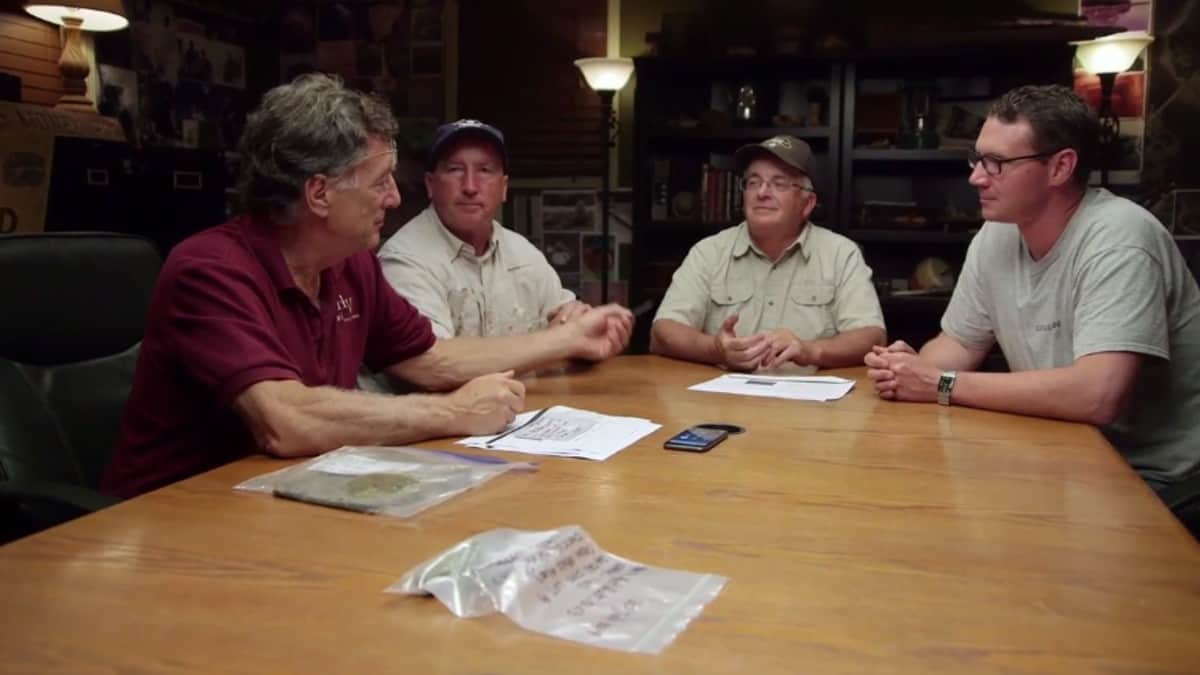
In this week’s episode of The Curse of Oak Island metal detectorist, Gary Drayton made a discovery at Smith’s Cove that got everybody’s hearts pumping.
Rick Lagina, Peter Fornetti, and Gary headed down into the mud at the end of the slipway at Smith’s Cove, hoping to find wee bits of treasure. Rick and Peter looked on tensely as Gary waved his detector over the rocks; dramatic music helped build up the tension.
Finally, we heard Gary’s detector making a series of beeping noises that seem to vary in pitch. Peter came rushing in with his spade, and after a few moments, they managed to get a fragment of metal out of the ground. Gary initially admitted to being stumped, but then announced: “This could be silver, mate.”
?#CurseOfOakIsland pic.twitter.com/QKlHxP0rrI
— Curse of Oak Island (@CurseOfOak) January 17, 2020
Gary reckoned it was a silver tag and that it featured an inscription. Its condition reminded the detectorist of Spanish silver coins he’d found previously, “it’s been down there a heck of a long time… 300/400 years,” he suggested. The guys began to wonder if they’d actually found a piece of the Oak Island treasure.
Rick displayed a cool head by intimating that they shouldn’t get too excited until the fragment is tested. Although he does allow himself to speculate that it could be “the first piece of real treasure found at Smith’s Cove.”
What did the testing say?
Later the guys gathered in the war room to hear what Professor of Chemistry, Dr. Christa Brousseau, had to say about Gary’s fragment.
We could see the disappointment on their faces, perhaps a little bit of embarrassment on the part of Gary when Dr. Brosseau told the guys that the object is made of impure lead. This means the artifact is mostly lead with a bit of tin and antimony, so, not exactly treasure. All is not lost, however, as the Doctor pointed out that it’s still an ancient artifact.
Steve Guptill asked, “could it have been used in the building of the slipway?”
Gary responded, “well, it [lead] was the duct tape of the day, going right back to Roman times.”
The guys decided that with isotope testing, they would be able to learn more about where the fragment is from.
Therefore, after the initial disappointment, excitement rose again as to what they might learn from the fragment, “lead has told us more stories than any other metal,” says Marty.
After more testing, the guys assembled back in the War Room to hear the results. Expert geochemist Chris MacFarlane slowly and deliberately told the guys that the fragment is not North American. He thought it European and most likely from the western side of the Mediterranean, probably Spain, France, or Italy.
Gary pipes up, “we all know who used to travel those Meditteranean trade routes, Templars, baby!”

Whether or not the fragment did belong to Templar knights is unclear, but what it is clear is that its geographic origin is evidence of European involvement in Oak Island from centuries past.
Spanish and French connections with Oak Island keep popping up, but this was the first time that a possible Italian link had been mentioned, something that considerably cheered the Lagina brothers.
As Craig Tester suggested, it may be time “to reach out to Europe,” so we can find out what’s going on.
The Curse Of Oak Island airs Tuesdays at 9/8c on History.